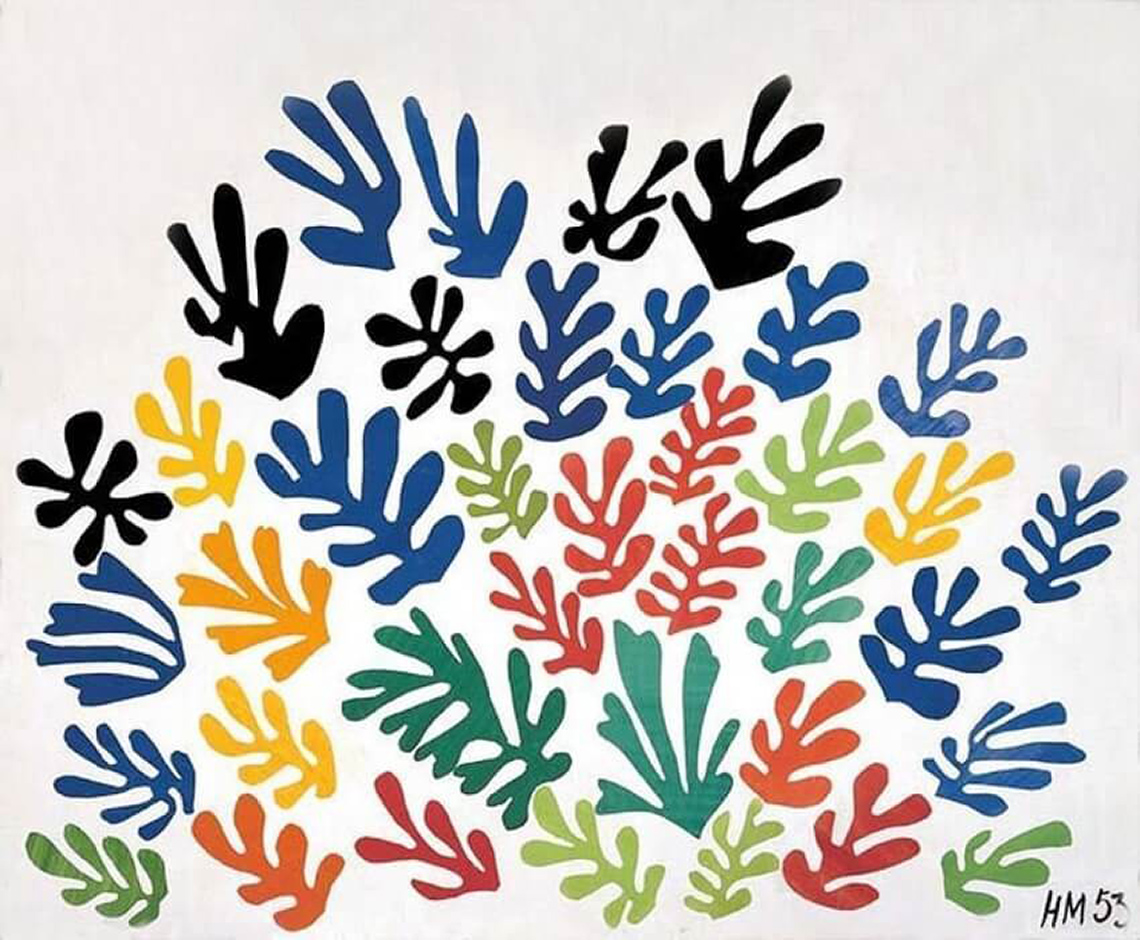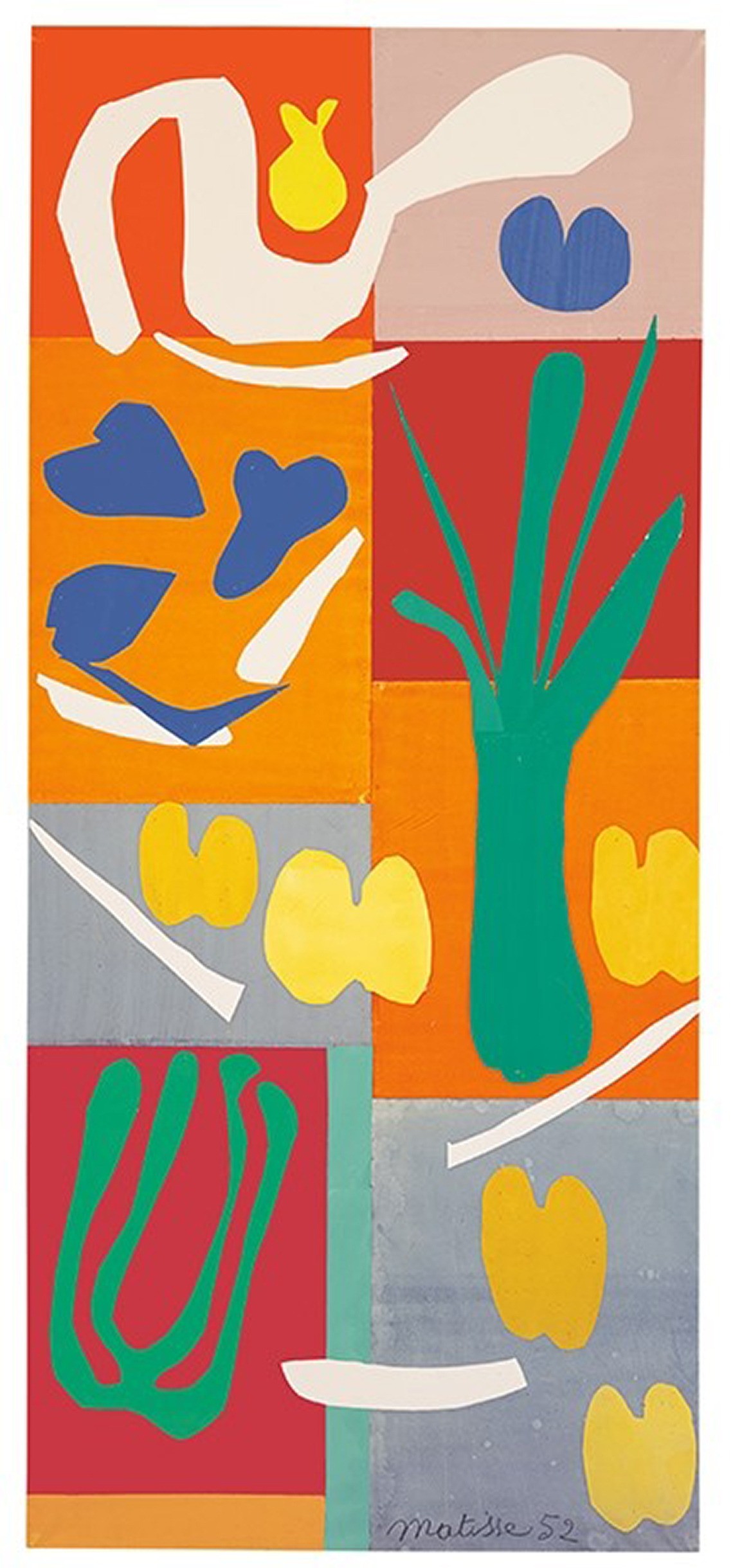Minds On
Let’s get started!
Shapes in art
What shapes do you recognize in Beasts of the Sea by Henri Matisse?
Can you find shapes that remind you of…
- a playful fish?
- a floating seahorse?
- spiral shells?
- waving seaweed?
- curvy coral?

Beast of the Sea by Henri Matisse, 1950
An artpiece that has different irregular cut out shapes of different colours arrange in 2 vertical columns. The background of the 2 columns are various coloured rectangles and triangular shapes layered on top of each other. In the first column there is a spiral cutout at the top, then some free-formed cut out shapes that are curvy, several triangle shapes bunched up on one side, and 2 free-formed cut out shapes that are rounded, branching, finger like projectiles at the bottom. In the second column there are some free-formed cut out shapes that are curvy in the top half, then under it is a spiral cut-out and at the bottom are 3 cut-out wavy like lines.
What about geometric shapes like squares, rectangles, and triangles?
What is a geometric shape?
A shape with regular edges. For example, a square, a circle, and a triangle are geometric shapes.
Action
Get ready, get set…
Henri Matisse
Henri Matisse was a French artist. He really liked to use shapes in his artwork.
He used 2 different types of shapes in his artwork.
He used geometric shapes like circles, squares, rectangles, and triangles. These are shapes with regular edges.

He also used organic shapes in his art. These are shapes with irregular edges. Those are shapes we often find in nature like leaves, rocks, clouds and animals.

What do you notice are some of the similarities and differences between organic and geometric shapes?

A chart comparing geometric and organic shapes. Geometric shapes are closed shapes, symmetrical, and have regular edges. Organic shapes are closed shapes, asymmetrical, and have irregular edges.
Henri Matisse liked to do all types of art. He drew, he painted, and sculpted.
When he got older, he started making collages.
What is collage?
A collage is when an artist cuts shapes out of paper and then glues them onto another paper. The work collage comes from the French word “coller” which means to glue.
Go!
Spot the shapes
The following are some more examples of Henri Matisse's collages.
Can you spot the organic or geometric shapes?
Collage 1: The Sheaf

The Sheaf by Henri Matisse, 1953
For the sentence, select the missing word or phrase from the drop-down menu.
Collage 2: Memory of Oceania

Memory of Oceania by Henri Matisse, 1952-3
A collage of different cut-out shapes of various colours. The background is white with 2 large yellow rectangles on the right and middle of the collage and some thin curved and irregular lines on the bottom half of the collage. On the top left corner are 2 irregularly cut out shapes that are blue and yellow. On the bottom corners are irregularly cut out shapes in blue, red, green, and yellow. There's a large green rectangle going diagonally across the right side of the collage. Attached to the top and bottom of the rectangle are blue rectangles. Slightly overlaying the bottom of the green rectangle is a black, thin curved irregularly cut out shape and a thin red rectangle that goes vertically from the top of the right side of the collage to near the midcdle.
For each sentence, select the missing word from the drop-down menu.
Explore the collage Memory of Oceania. Next, read the following sentences and select whether the shapes are geometric or organic.
Collage 3: Vegetables

Vegetables by Henri Matisse, 1952
A collage. The background are several rectangles of different sizes and colours. On top of the background are different irregularly cut out shapes of different colours. The shapes resemble different types of vegetables.
For each sentence, select the missing word from the drop-down menu.
Explore the collage Vegetables. What do you notice about the shapes the vegetable shapes? Read the following sentences and select whether the shapes are geometric or organic.
Consolidation
Putting it all together
Shape sort
Now that we have explored some of Henri Matisse's collages and how he used organic and geometric shapes it's your turn to sort some shapes.
Collage 4: The Horse, the Rider, and the Clown

The Horse, the Rider, and the Clown by Henri Matisse, 1947
A collage. There is a solid-coloured border and background. On top of the border are irregularly cut out shapes. On the bottom-left and top-right corners are quarters of circles that have irregularly cut out shapes layered on top patterns. Coming out of the top right quarter circle is a cut out that is in the shape of a horse's head and 2 front legs. Going across the collage on top of the horse is a curved line that forms a sideways 'S' shape. The horse is surrounded by more irregular shapes.
For each sentence, select the missing word from the drop-down menu.
Portfolio
Portfolio reflection
Reflect on the following questions:
- How do you feel about this collage?
- What do you think is the most important thing in this work?
- How did the artist use shape to make you see what is most important to them?
Record your ideas using a method of your choice in your art portfolio.
Reflection
How do you feel about what you have learned in this activity? Which of the next four sentences best matches how you are feeling about your learning? Press the button that is beside this sentence.
I feel…
Now, record your ideas about your feelings using a voice recorder, speech-to-text, or writing tool.